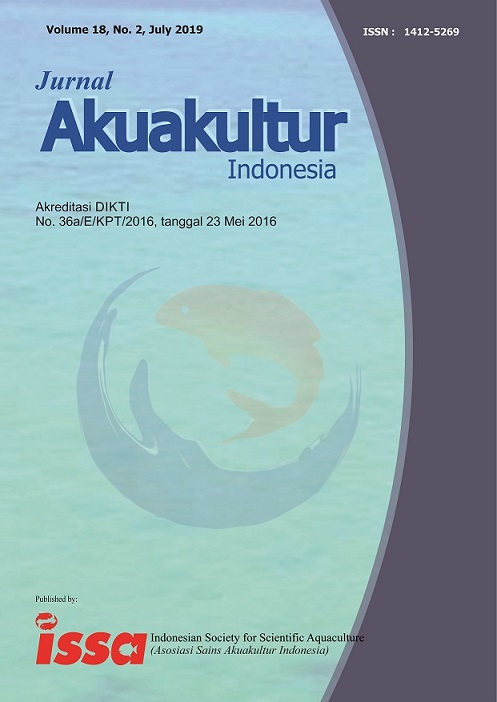Seaweed extract of Gracilaria verrucosa as an antibacterial and treatment against Vibrio harveyi infection of Litopenaeus vannamei
Abstract
ABSTRACT
The objectives of this study were to investigate the antibacterial activity of G. verrucosa extract in test inhibitory zone with different concentrations (500, 1000, 1500, and 2000 mg/L) and to examine G. verrucosa extract with different dosage (0.5, 1.0, 1.5, 2.0 g/kg) in feed on immune responses (total hemocytes count, phagocytic activity, phenoloxidase activity, respiratory burst) and survival rate in the Litopenaeus vannamei against the pathogenic Vibrio harveyi. Pacific white shrimp with an initial body weight of 5.25±0.55 g was reared in the aquarium (60×30×30 cm3) with a density of 10 shrimp/aquarium. Pacific white shrimp had been fed three times a day as much as 3% in at satiation for 14 days after challenged with V. harveyi. The first results of the inhibitory test showed that all the concentration of G. verrucosa extract was able to inhibit the growth of V. harveyi and the second result showed that the extract of G. verrucosa can increase the immune responses of shrimp. In the result of survival showed that shrimp fed with 0.5, 1.0, 1.5, and 2.0 g/kg has 80, 73, 70, and 70%, respectively. In conclusion, the seaweed extract of G. verrucosa has antibacterial activity and can induce the immune responses and resistance of Pacific white shrimp against V. harveyi infection.
Keywords: Gracilaria verrucosa, seaweed, Vibrio harveyi, vibriosis, Litopenaeus vannamei
ABSTRAK
Tujuan dari penelitian ini adalah untuk menguji aktivitas antibakteri ekstrak G. verrucosa dalam uji zona hambat dengan konsentrasi yang berbeda (yaitu 500, 1000, 1500, dan 2000 mg/L) dan studi perlakuan pengobatan untuk menguji ekstrak G. verrucosa pada pakan dengan dosis yang berbeda (yaitu 0,5; 1,0; 1,5; dan 2,0 g/kg) pada respons imun (yaitu jumlah total hemosit, aktivitas fagositik, aktivitas fenoloksidase, respiratory burst) dan tingkat kelangsungan hidup pada udang vaname terhadap bakteri patogen Vibrio harveyi. Udang vaname dengan berat badan awal 5,25 ± 0,55 g dipelihara di akuarium (60 × 30 × 30 cm3) dengan kepadatan 10 udang/akuarium. Udang vaname pasifik diberi makan tiga kali sehari 3% at satiation selama 14 hari setelah di uji tantang V. harveyi. Hasil pertama dari uji zona hambat menunjukkan bahwa semua konsentrasi ekstrak G. verrucosa mampu menghambat pertumbuhan V. harveyi dan hasil kedua menunjukkan bahwa pemberian ektrak G. verrucosa dapat meningkatkan respon imun udang. Hasil tingkat kelangsungan hidup menunjukkan bahwa perlakuan pakan udang dengan dosis 0,5; 1,0; 1,5; dan 2,0 g/kg memiliki tingkat kelangsungan hidup masing-masing 80, 73, 70, dan 70%. Kesimpulannya, ekstrak rumput laut G. verrucosa memiliki aktivitas antibakteri dan dapat menginduksi respons imun & ketahanan udang terhadap infeksi V. harveyi.
Kata kunci: Gracilaria verrucosa, rumput laut, Vibrio harveyi, vibriosis, udang vaname
Downloads
Authors who publish with this journal agree to the following terms:
- Authors retain copyright and grant the journal right of first publication with the work simultaneously licensed under a Creative Commons Attribution License that allows others to share the work with an acknowledgement of the work's authorship and initial publication in this journal.
- Authors are able to enter into separate, additional contractual arrangements for the non-exclusive distribution of the journal's published version of the work (e.g., post it to an institutional repository or publish it in a book), with an acknowledgement of its initial publication in this journal.
- Authors are permitted and encouraged to post their work online
 (e.g., in institutional repositories or on their website) prior to and during the submission process, as it can lead to productive exchanges, as well as earlier and greater citation of published work (See The Effect of Open Access).
(e.g., in institutional repositories or on their website) prior to and during the submission process, as it can lead to productive exchanges, as well as earlier and greater citation of published work (See The Effect of Open Access).



















